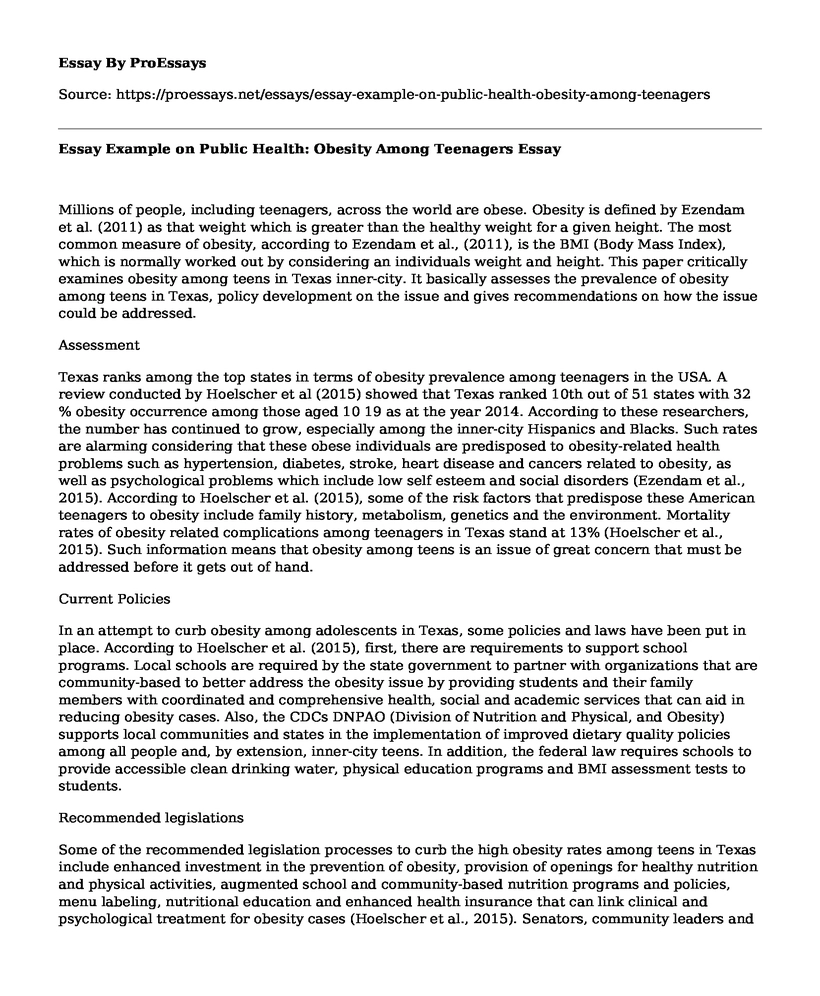Millions of people, including teenagers, across the world are obese. Obesity is defined by Ezendam et al. (2011) as that weight which is greater than the healthy weight for a given height. The most common measure of obesity, according to Ezendam et al., (2011), is the BMI (Body Mass Index), which is normally worked out by considering an individuals weight and height. This paper critically examines obesity among teens in Texas inner-city. It basically assesses the prevalence of obesity among teens in Texas, policy development on the issue and gives recommendations on how the issue could be addressed.
Assessment
Texas ranks among the top states in terms of obesity prevalence among teenagers in the USA. A review conducted by Hoelscher et al (2015) showed that Texas ranked 10th out of 51 states with 32 % obesity occurrence among those aged 10 19 as at the year 2014. According to these researchers, the number has continued to grow, especially among the inner-city Hispanics and Blacks. Such rates are alarming considering that these obese individuals are predisposed to obesity-related health problems such as hypertension, diabetes, stroke, heart disease and cancers related to obesity, as well as psychological problems which include low self esteem and social disorders (Ezendam et al., 2015). According to Hoelscher et al. (2015), some of the risk factors that predispose these American teenagers to obesity include family history, metabolism, genetics and the environment. Mortality rates of obesity related complications among teenagers in Texas stand at 13% (Hoelscher et al., 2015). Such information means that obesity among teens is an issue of great concern that must be addressed before it gets out of hand.
Current Policies
In an attempt to curb obesity among adolescents in Texas, some policies and laws have been put in place. According to Hoelscher et al. (2015), first, there are requirements to support school programs. Local schools are required by the state government to partner with organizations that are community-based to better address the obesity issue by providing students and their family members with coordinated and comprehensive health, social and academic services that can aid in reducing obesity cases. Also, the CDCs DNPAO (Division of Nutrition and Physical, and Obesity) supports local communities and states in the implementation of improved dietary quality policies among all people and, by extension, inner-city teens. In addition, the federal law requires schools to provide accessible clean drinking water, physical education programs and BMI assessment tests to students.
Recommended legislations
Some of the recommended legislation processes to curb the high obesity rates among teens in Texas include enhanced investment in the prevention of obesity, provision of openings for healthy nutrition and physical activities, augmented school and community-based nutrition programs and policies, menu labeling, nutritional education and enhanced health insurance that can link clinical and psychological treatment for obesity cases (Hoelscher et al., 2015). Senators, community leaders and agencies such as the Centre for Disease Control, Texas Education Agency and the Texas Department of State Health Services can be very instrumental because they are better placed to promote the implementation of obesity prevention initiatives. Interagency coordination and communication across agencies could also be enhanced to help reduce obesity cases among inner-city teens.
Conclusion
Some of the new initiatives that could help curb the escalation of obesity among teens in Texas include the emphasis on both physical activities and healthy eating habits to boost fitness, tailored educational programs that encourage healthy lifestyles and school-based health wellness programs. Nevertheless, cultural issues such as eating customs should be considered so that they do not interfere with the expected outcomes. Interested parties such as education policy makers, PEP and CDC as well as collaboration between the state government of Texas and the Federal government can be of great help in following up the implementation of such recommendations. As such, obesity among teens will be significantly reduced.
References
Hoelscher, D. M., Butte, N. F., Barlow, S., Vandewater, E. A., Sharma, S. V., Huang, T., ... & Oluyomi, A. O. (2015). Incorporating primary and secondary prevention approaches to address childhood obesity prevention and treatment in a low-income, ethnically diverse population: study design and demographic data from the Texas Childhood Obesity Research Demonstration (TX CORD) study. Childhood Obesity, 11(1), 71-91.
Ezendam, N., Springer, A., Brug, J., Oenema, A., & Hoelscher, D. (2011). Do Trends in Physical Activity, Sedentary, and Dietary Behaviors Support Trends in Obesity Prevalence in 2 Border Regions in Texas?. Journal Of Nutrition Education And Behavior, 43(4), 210-218. http://dx.doi.org/10.1016/j.jneb.2009.11.009
Cite this page
Essay Example on Public Health: Obesity Among Teenagers. (2021, Mar 24). Retrieved from https://proessays.net/essays/essay-example-on-public-health-obesity-among-teenagers
If you are the original author of this essay and no longer wish to have it published on the ProEssays website, please click below to request its removal:
- Food Addiction Paper Example
- Essay Sample on Workplace Safety for A Hospital
- Argumentative Essay on Needle Exchange Policy
- 3 Contemporary Issues Impacting Correctional Management - Essay Sample
- Essay Example on Maximizing Outcomes Through Ambulatory Service Centers: A Critical Analysis
- Essay Sample on African-Americans: Cast Down Your Bucket Where You Are
- Commitment to Social Work: Pursuing a Master's Degree with a Focus on Social Justice and Diversity - Free Paper







